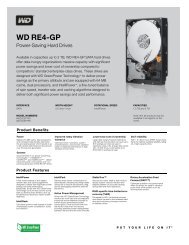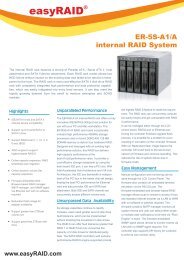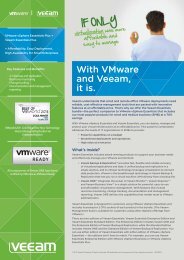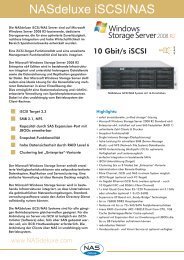Active-Active vs. Active-Passive - starline Computer GmbH
Active-Active vs. Active-Passive - starline Computer GmbH
Active-Active vs. Active-Passive - starline Computer GmbH
You also want an ePaper? Increase the reach of your titles
YUMPU automatically turns print PDFs into web optimized ePapers that Google loves.
2<br />
INTRODUCTION<br />
www.open-e.com<br />
ENTERPRISE CLASS STORAGE OS<br />
for EVERY BUSINESS<br />
The purpose of this document is to compare two high availability failover configurations, namely <strong>Active</strong>-<strong>Active</strong> and <strong>Active</strong>-<br />
<strong>Passive</strong>, both being possible to configure using Open-E DSS V7 software*.<br />
The comparison was entrusted with two tests conducted by the Open-E Quality Assurance Team, measuring respectively:<br />
data throughput performance and failover switching time.<br />
Apart from presenting tests results and conclusions, this document provides brief descriptions of both configurations.<br />
.<br />
*To take advantage of <strong>Active</strong>-<strong>Active</strong> functionality, an additional Feature Pack - <strong>Active</strong>-<strong>Active</strong> iSCSI Failover of the<br />
Open-E DSS V7 software is required.<br />
HIGH AVAILABILITY OVERVIEW<br />
Last year (2011), Science magazine published an<br />
interesting study presenting measurements of world’s<br />
total technological capacity to communicate, store, and<br />
compute information.<br />
According to the publication: “in 2007, humankind was able<br />
to store 2.9 × 10 20 optimally compressed bytes and carry<br />
out 6.4 × 10 18 instructions per second on general-purpose<br />
computers”[1]. At the same time: “general-purpose<br />
computing capacity grew at an annual rate of 58%” [1].<br />
With amount of data increment at this rate, the need to<br />
effectively store data becomes a priority.<br />
Thinking of “effective” ways of storing data – the key<br />
element is continuous availability of storage solutions.<br />
Availability of resources is one of the concerns of Business<br />
Continuity. Planning involved in that field is about ensuring<br />
that companies will be able to operate in case of a serious<br />
disruption.<br />
IT components availability has become increasingly<br />
important since businesses are more and more dependent<br />
on digital information and technology.Considering<br />
industries as candidates for implementing high availability<br />
solutions, we can name healthcare, banking, online<br />
retail and many more. All of them require continuous,<br />
uninterrupted access to their resources.<br />
A standard for availability of the products or systems is<br />
known as “class of 9s”.<br />
Downtime Costs $26.5 Billion in Lost Revenue<br />
It refers to the percentage figures used for the<br />
representation of high availability (e.g. 99.999% is five<br />
nines). For example, in case of availability value of 98 %,<br />
the downtime will equal 2 %. Downtime easily translates<br />
to lost revenue.<br />
High availability is a goal for storage solutions. The priority<br />
is for data or services to be accessed at all times, even if<br />
malfunction occurs. This can be achieved in a number of<br />
ways involving clustering, redundancy and software that<br />
handles the failover configurations.<br />
High Availability clusters, with priority to decrease<br />
downtime to a minimum, are one of the implementations<br />
of these solutions. Such clusters are usually supported by<br />
storage management software and Open-E DSS V7 can be<br />
an example of those.<br />
Typically, a high availability cluster consists of two nodes.<br />
In case of a node failure, the client network connections<br />
and file systems are moved or mounted to the other node,<br />
so the downtime is minimized or eliminated completely.<br />
An operation of switching to a redundant or synchronized<br />
node is called failover. In contrast, failback is the process<br />
of restoring a system, component or service to a state<br />
before failure.<br />
There are two major configurations for implementation<br />
of high availability storage solutions – <strong>Active</strong>-<strong>Passive</strong><br />
and <strong>Active</strong>-<strong>Active</strong>. Let us briefly describe them, before<br />
presenting the results.<br />
“…more than $26.5 billion in revenue is lost each year from IT downtime, which translates to roughly $150,000 is lost<br />
annually for each business (…). Of the 200 companies surveyed, small enterprises lost, on average, more than $55,000<br />
in revenue due to IT failures each year, while midsize companies lost more than $91,000 and large companies lost<br />
more than $1,000,000.”<br />
Source: Information Week, 2011 [2].
















